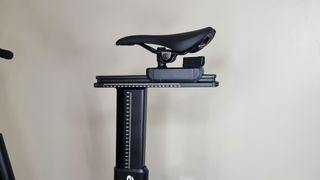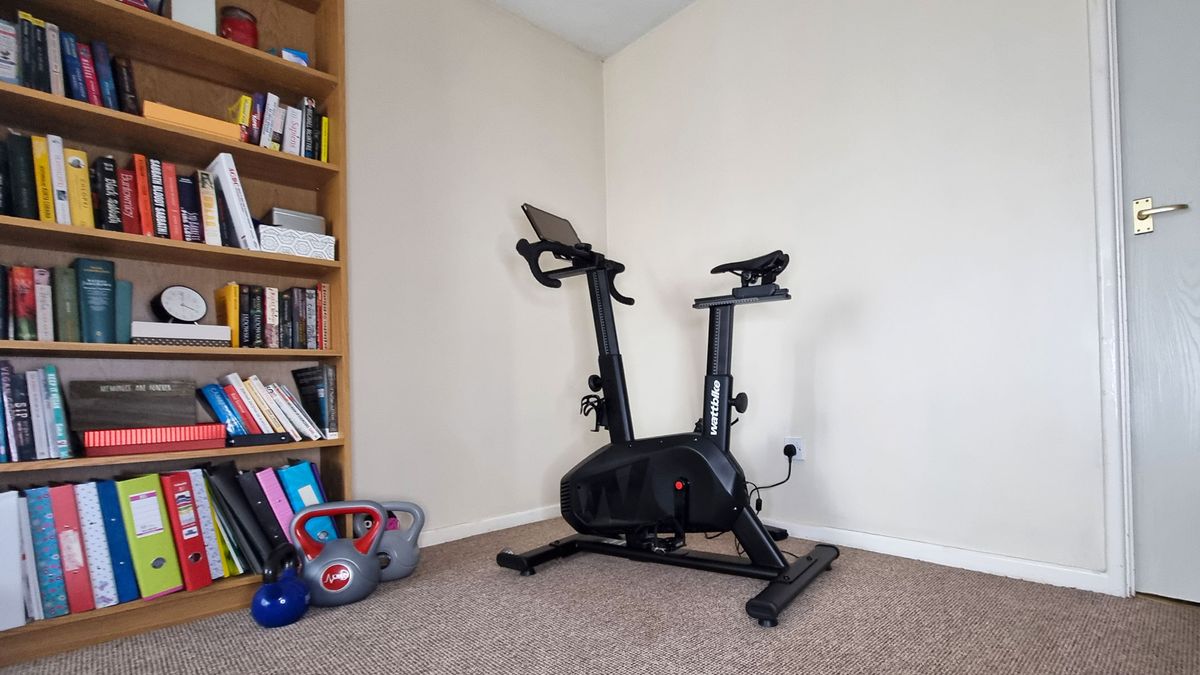If you know a thing or two about cycling, Wattbike needs no introduction. This brand is a household name in the fitness industry and many athletes have come to endorse its flagship Wattbike Atom smart bike since its release nearly five years ago. Why? Its meticulous approach to workout tracking makes Wattbike a go-to for those serious about boosting their cycling performance. This also means that Wattbike machines do not tend to be a first choice for the average exerciser — but this may be about to change.
The brand released a new model called the Wattbike Proton in the U.K. in September last year and plans to launch it in the U.S. sometime in early 2025. This smart bike was essentially designed to appeal to a broader audience, including those who would typically opt for something more fun-oriented like a Peloton bike. The Proton is slightly less powerful and “beefy” than the Atom, but on the whole, has the same key features and offers a similarly realistic riding experience.
The biggest difference is in the design. Thanks to its adjustable saddle and handlebars, the Wattbike Proton suits a much wider range of users (including children taller than 4 ft 6 in/137 cm), and it takes up less floor space. It could well be one of the best exercise bikes for family use. Plus, this smart bike is said to be priced at $2,499 — making it a wallet-friendly alternative to premium models like the Wahoo Kickr Bike.
Wattbike Proton smart bike review
Wattbike Proton: Set up and usability
- User height range: from 4 ft 6 in to 6 ft 6 in (1.37 to 1.98m)
- Maximum user weight: 297.6 lbs (135 kg)
- Free Wattbike Hub app
The Wattbike Proton is one of the most adjustable exercise bikes we have tested. As mentioned before, it suits user heights from 4 ft 6-inches to 6 ft 6 -inches (1.37 m to 1.98 m), making it accessible to both children and adults, and the maximum user weight is set at an impressive 297.6 lbs (135 kg). For comparison, the pricier Wahoo Kickr Bike can only hold up to 250 lbs (113 kg).
Our testing unit came fully put together, so we can’t comment much on the assembly process. However, setting up our Wattbike Proton was swift, intuitive and required no tools. The handlebar and saddle heights can be adjusted by turning the knobs and dialing them into the right position.

Once the bike is set up, it connects to your phone or tablet — either through the default Wattbike Hub app, or by way of third-party apps like Strava or Zwift. However, that does not mean you have to pay for a subscription to use the Proton. The Wattbike Hub app is largely free (only a handful of non-essential features are hidden behind a paywall) and has all the key features you may need for effective training, from in-depth workout stats to guided workouts and performance tests.
Since the Wattbike Proton supports Bluetooth and ANT+ connectivity, it can also be used alongside fitness trackers, heart rate monitors and other health devices.
Wattbike Proton: Design
- Heavy and difficult to move around
- Easy to mount and comfortable to ride
- The control buttons can be fiddly
Key specs
Approximate dimensions (in): 38 x 40 x 22 (H x L x W)
Approximate dimensions (cm): 98 x 102 x 57 (H x L x W)
Weight: 105.8 lbs (48 kg)
User height range: 4 ft 6 in to 6 ft 6 in (1.37 to 1.98 meters)
Max user weight: 297.6 lbs (135 kg)
Drive type: Chain
Resistance: Electromagnetic
Maximum power output: 1800 Watts
Display: None
Warranty: Two years
Compatibility: Wattbike Hub and third-party apps
Other features: Drinks holder, device holder
The Wattbike Proton is relatively small when compared to other smart bikes, making it a good option for those short on space. It is also portable, thanks to a pair of wheels at the front of the unit. However, we still found it quite difficult to move around. The bike weighs a solid 105.8 lbs (48 kg) and its wheels did not always glide smoothly on our carpets (hard floors might be easier in that regard), so it did take some strength to maneuver it around the room.
That said, we liked the user-friendly design of our Wattbike Proton. The saddle was quite thin, but surprisingly well-cushioned and comfortable to ride — and that does not happen often in smart bikes. The wide handlebars offered a good grip, the pedals did not feel stiff, and the device mount kept our tablet stable even during the most intense rides.
We also liked that the Wattbike Proton has a step-through design, meaning you do not have to swing your leg over the top to get on the saddle. This makes it more accessible for those with balance issues or poor hip mobility than smart bikes with a step-over design, such as the Wahoo Kickr Bike or Wattbike Atom.
The control buttons were the only thing we did not like about our Wattbike Proton. They are located on the handlebars, right under the fingers, and at least in theory should not be too difficult to find and press at the right time. In practice, however, these buttons can be hit-and-miss. Their squidgy design makes them quite fiddly and it is not always obvious if you have actually pressed them. The response from the bike can be quite sluggish, too (more on that later.)
Wattbike Proton: Features
- Gear and Ergo modes
- Plenty of workout-tracking features
- Pedaling Effectiveness Score (PES)
The Wattbike Proton has two modes. In Gear mode, you use the buttons to change gear, just like you would on an outdoor bike. In Ergo mode, on the other hand, you stick to your target wattage no matter how quickly you pedal. Put simply, the slower you go, the more resistance you have to overcome.
There are plenty of workout-tracking features available on the Wattbike Hub app, from basic metrics such as cadence and distance to advanced performance indicators like the Wattbike’s signature Pedaling Effectiveness Score (PES).
Unique to the brand, the PES ranges from 0 to 100 and reflects the efficiency of your pedaling technique, based on the data collected by the power sensors located in the crank and pedals. The higher your score, the better your muscle engagement and power generation. Each PES score comes with a graph that helps the rider identify areas for improvement. For example, when there is not enough force at the top and bottom of the pedal stroke, the PES graph looks like a figure of eight.
The Wattbike Hub app also features dozens of training plans, guided workouts and fitness tests. While it is not the most robust or aesthetically pleasing fitness platform we have tested, the Wattbike Hub did a good job of keeping us fit. The app is well-structured, customizable and relatively easy to use.
However, it is nowhere near as fun and engaging as the Peloton app, for example. The Wattbike Hub app has no instructor-led classes, rides on location or fun little challenges that keep users coming back for more. While this is not a huge issue for seasoned cyclists, beginners and those who struggle with sticking to their exercise routine may be put off by this lack of “fun” features, unless they opt for subscription-based apps like Zwift.
Wattbike Proton: Performance
- Sturdy and balanced
- Pedal vibrations can be noisy
- App connectivity can be patchy
Performance-wise, the Wattbike Proton is a solid workhorse. This smart bike may not have the technical finesse of more premium models, but it is sturdy and reliable. It did not wobble or shake, even during the most sweaty and lung-busting workouts. We also liked its wide range of resistance, with enough settings to satisfy users of all fitness levels. However, some performance hiccups can spoil the overall experience.
For example, gear changes can be frustrating at times. As we mentioned before, the control buttons are quite fiddly and may be slow to respond. This in turn can affect how efficiently you change the settings during exercise, often diverting your attention away from the workout itself. It can be annoying if you are in the midst of an intense ride and your bike does not behave how you want it to.
Secondly, the Wattbike Proton can be quite loud, mostly due to excessive pedal vibrations. When we measured the noise levels made by the bike with the Sound Meter decibel-counting app, we noted sounds as high as 70 dB — equivalent to a washing machine or a hair dryer. While we would not consider this a deal-breaker (exercise bikes are generally quite noisy), it is something to take into account if you live in small or crowded spaces.
Lastly, we had some minor issues with the app connectivity. On several occasions, the Wattbike Hub app struggled to connect with our bike, and the data transmission was lagging badly. In all fairness, though, most Wattbike Hub users do not seem to be having these issues.
Should you buy the Wattbike Proton?
✅ Buy it if: You are a passionate cyclist looking to improve your exercise performance, but don’t want to spend an arm and a leg on a premium smart bike. The Wattbike Proton is also a good choice for multi-person households, mostly thanks to its wide adjustability and sturdy, reliable design.
❌ Don’t buy it if: You are a cycling novice or someone who struggles with sticking to your exercise routine. The Wattbike Proton lacks some of the “fun” features that help boost engagement and motivation, such as instructor-led fitness classes or rides on location. It is also relatively loud.
If this product is not for you
If you want a top-class smart bike (and do not mind spending an eye-watering $3,999), check out the Wahoo Kickr Bike. It is a beast of a machine, highly customizable and widely compatible with third-party apps, and unlike most bike trainers on the market, it comes with incline changes so it can better simulate outdoor conditions. A real treat.
Looking for something cheaper? Consider the Zwift Ride. This bike setup is compact, intuitive to use and smooth to ride, but more importantly, it delivers a great smart bike experience for just under $1,300.
Want something more beginner-friendly? The Peloton bike is a great alternative here. This iconic exercise machine has plenty of engaging fitness content on offer, such as fun instructor-led fitness classes, and it is exceptionally well made, too. Plus, it is cheaper than the Wattbike Proton by around $1,000.
Wattbike Proton: How we tested
We tested the Wattbike Proton for nearly a month, assessing its design, features, performance and ease of use. We put this smart bike through a range of workouts, including gentle active recovery rides and high-intensity sprints, working through a wide range of resistance settings. We also gave our verdict on the accessibility, connectivity and value for money of the Wattbike Proton.
